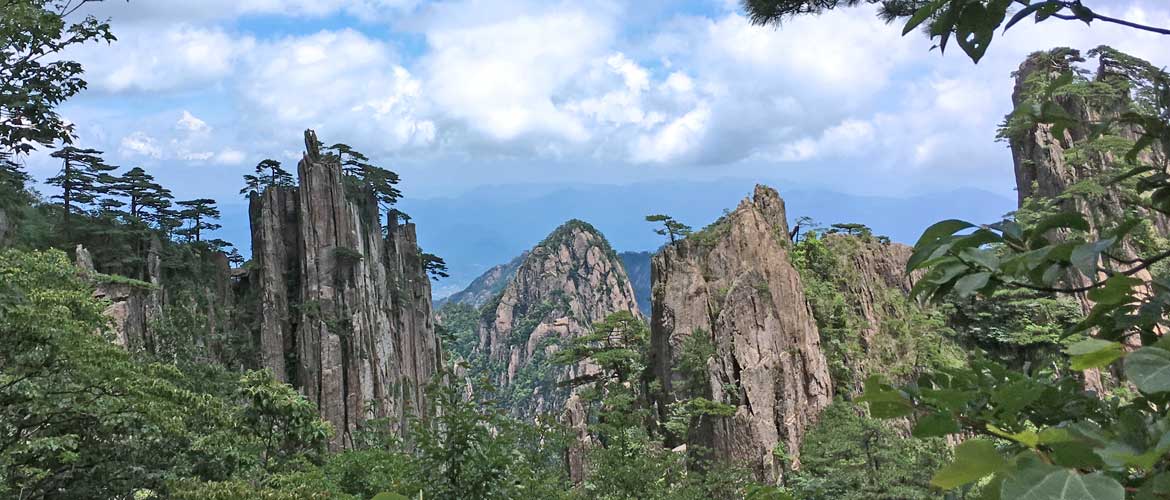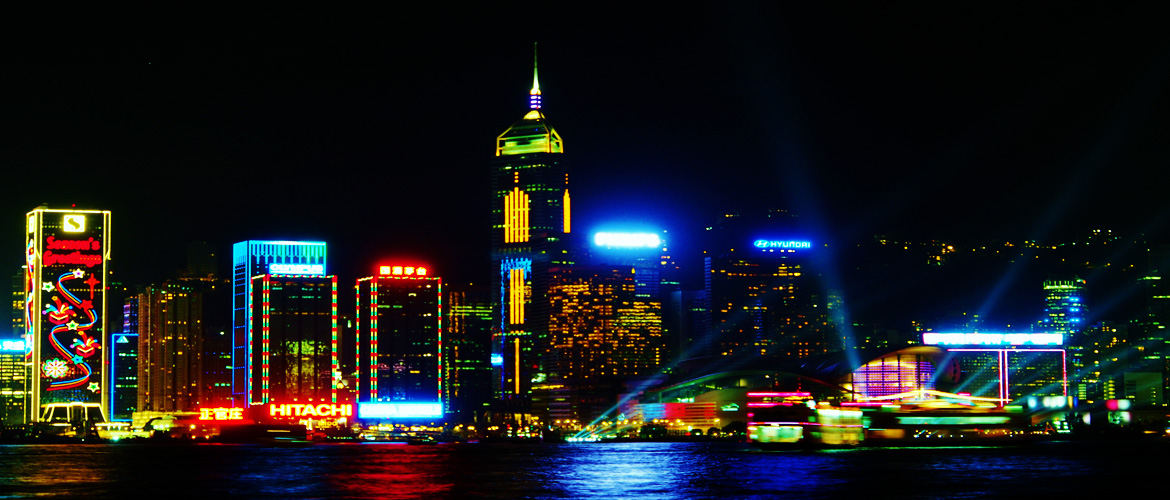Beijing – Jinan – Qufu – Suzhou – Shanghai – Huangshan – Wuyishan – Longyan – Xiamen – Guangzhou – Shenzhen – Hong Kong
Discover the essence of China on this Splendid China tour, a journey that spans the country’s most iconic sites and hidden treasures. From the majestic Great Wall to the bustling streets of Hong Kong, from the stately Temple of Confucius to the breathtaking Yellow Mountain and Mount Wuyi, this itinerary offers a perfect blend of historical exploration, natural wonders and modern indulgence.
Important Features
- Small group size – maximum 20.
- Inter-city travel by high-speed rail.
- Expert guides handpicked by company owners.
- No annoying forced shopping of any kind.
- Quality meals at non-tourist restaurants.
- Unlimited supply of bottled water during group activities.
- Free Wi-Fi in all hotels.
Pre- or post-tour extension to Xi’an, Chengdu & Guilin available on request.
Meal Code: B = breakfast / L = lunch / D = dinner
Day 1/Thu: Departing for Beijing
The trip starts with your transpacific flight departing from a city of your choice. You’ll lose a day upon crossing the International Date Line.
Day 2/Fri: Arrival in Beijing
Meet the driver on arrival for transfer to the hotel. You’ll have the remainder of the day at leisure.
Day 3/Sat: Beijing (B/L/D)
Beijing is China’s capital, a major cultural and educational hub with a population of 22 million. Known for its opulent palaces, temples, and historic walls, it is the country’s most visited city.
Today’s itinerary begins with a visit to the Forbidden City, home to emperors from the Ming and Qing Dynasties. This UNESCO World Heritage Site, completed in 1420, consists of 980 buildings spread across 72 hectares.
Next, visit Tian’anmen Square, one of the world’s largest public squares and a focal point of China’s modern history.
In the afternoon, explore the Temple of Heaven, another UNESCO site, where emperors once conducted grand sacrifices.
If you’re interested in shopping, the Hongqiao Pearl Market is near near Temple of heaven is recommended.
We end the day with a traditional dinner featuring Beijing’s famous roast duck.
Day 4/Sun: Beijing (B/L)
After an early breakfast we embark on a full-day excursion to the legendary Great Wall at Mutianyu, 75 km northeast of the city.
Zigzagging over 6,000 kilometres from east to west along the undulating mountains, the Great Wall was built to hold off tribal invaders from the north. As history shows, the Wall failed the Chinese rulers miserably, especially in the case of Kublai Khan who and his men swept across China from the Mongolian steppe, thus the beginning of the Yuan Dynasty (1279-1368).
Construction of the earliest sections of the Wall started in the 7th century BCE. A major renovation started with the founding of the Ming Dynasty in 1368 and took 200 years to complete. The wall we see today in Beijing is almost exactly the result of this effort.
Day 5/Mon: Beijing – Jinan (B/L/D)
We begin our sightseeing today with a visit to a traditional hutong neighbourhood. Hutong refers to an ancient alleyway with siheyuan or ”4-sided courtyard house” on both sides. The name hutong dates back to the Yuan Dynasty (1279 – 1368 CE). According to some experts, the word originated from the Mongolian language, in which it is pronounced as hottog and means “well.” In ancient times, people tended to gather and live around wells. So the original meaning of hutong should be “a place where people live around”.
Next on our schedule is the Summer Palace, a well preserved UNESCO World Cultural Heritage Site. The imperial resort was first named Garden of Clear Ripples, which was burnt down by the allied forces of Great Britain and France in 1860 at the end of the Second Opium War (referred to as Arrow War by the British). Reconstruction started 25 years later and was completed in 1895 when the name was changed to Yi He Yuan (Garden of Good Health and Harmony). The design gives prominence to Longevity Hill, as well as Kunming Lake south of the hill. The sprawling complex covers an area of 290 hectares and the buildings inside consist of over 3,000 bays.
We travel to Jinan by high-speed train (#G19, 16:00/17:22). The rail journey through fertile farmland dotted with villages provides the visitor with an excellent way to enjoy the beautiful countryside.
Day 6/Tue: Jinan (B/L)
Nestled in the heart of Shandong Province, Jinan is often referred to as the “City of Springs” due to its stunning natural springs that have been celebrated for centuries. Known for its rich history, vibrant culture, and breathtaking landscapes, Jinan offers a unique blend of ancient tradition and modern life.
Our sightseeing today takes in beautiful Baotu Springs Park, Daming Lake and the Provincial Museum of Shandong.
Day 7/Wed: Jinan – Qufu (B/L)
The train ride to Qufu takes 31 minutes (G121, 11:48/12:19).
Qufu is the birthplace of Confucius (551-479 BCE) and a must-visit for those interested in Chinese history, philosophy, and culture. As the heart of Confucian heritage, the city is home to the Three Confucian Sites—the Confucius Temple, Confucius Mansion, and Confucius Cemetery—all UNESCO World Heritage Sites. Visitors can explore grand halls, ancient stone carvings, and centuries-old cypress trees while learning about Confucian teachings that shaped East Asian civilizations. Beyond history, Qufu offers a unique cultural atmosphere, with traditional rituals, classical architecture, and a deep sense of reverence for China’s most influential philosopher.
The afternoon sightseeing begins at the massive Confucius Temple which features a series of impressive gateways, clusters of twisted pines and cypresses, inscribed steles and tortoise tablets recording ancient events.
We then proceed to Confucius Forest – the last resting place of Confucius and a cemetery for his descendants. The cemetery, the residence and the temple together form the UNESCO designated World Heritage Site in Qufu. If time allows, we will visit a village nearby.
Day 8/Thu: Qufu (B/L)
This morning, after a tour of the Kong family mansion once inhabited by the descendants of Confucius, we have the balance of the day at leisure.
Day 9/Fri: Qufu – Suzhou – Shanghai (B/L)
This morning, we ride the high-speed train to Suzhou (G101, 08:36/11:43).
Ancient Suzhou is most famous for its gardens, canals and silk industry. In the late 13th century a Venetian named Marco Polo visited Suzhou and was very impressed by what he saw. He vividly described the prosperous silk industry and dubbed Suzhou “Venice of the East” due to the small waterways crisscrossing the city.
Our afternoon schedule takes in historic Tiger Hill, the Humble Administrator’s Garden, and a short canal cruise.
Afterwards, we continue on to Shanghai by high-speed train, which takes less than 30 minutes.
Day 10/Sat: Shanghai (B/L/D)
With a population close to 25 million, Shanghai is China’s largest city and a dynamic hub of global trade and cultural exchange. The city delights visitors from around the world with its futuristic skyline and historical landmarks.
We begin our day with a visit to Jade Buddha Temple located in an old neighbourhood. We then walk the famous Bund – a waterfront promenade with a riveting history.
After lunch, we stroll the historical People’s Park and adjacent People’s Square in the heart of the city. Originally part of the Shanghai Race Club first established in 1850, the park and the square are surrounded by world-class museums and shops, which attract millions of visitors each year.
We wrap up the day’s sightseeing with a tour of the exquisite Yu Garden in the old town centre.
Day 11/Sun: Shanghai (B)
Free day to explore on your own.
If you are interested in art and history, Shanghai Museum would be a great place to spend half a day. This museum houses a huge collection of precious national treasures. Shanghai Jewish Refugees Museum and Nanwaitan Fabric Market (high-end tailor shops) are also recommended.
Day 12/Mon: Shanghai – Huangshan/Yellow Mountain (B/L)
After a leisurely breakfast we ride the high-speed train (2 ½ hours) to the city of Huangshan, namesake of the famous mountain literally meaning Yellow Mountain.
Known among Chinese as the loveliest mountain in their country, Yellow Mountain inspires visitors with its striking low-hanging clouds, distinctly shaped granite rocks and twisted pine trees. The jagged range consists of more than 70 knifelike peaks with the highest one reaching 1,864 metres above sea level.Vegetation on the range is thickest below 1,100 metres (3,600 ft), with trees growing up to the timberline at 1,800 meters (5,900 ft). Huangshan is a frequent subject of traditional Chinese paintings and literature, as well as modern photography.
Afternoon sightseeing at Hongcun, a key component of the UNESCO World Heritage Site collectively known as Ancient Villages in Southern Anhui. The traditional village represents a type of non-urban settlement that largely disappeared or was transformed during the last century. The street plan, architecture and decoration, and the integration of houses with comprehensive water systems are unique surviving examples.
Day 13/Tue: Huangshan Scenic Area (B/L/D)
After breakfast, we drive to the mountain and reach one of the peaks by cable car, thus beginning our full day exploration of the mountain. Located in the southern part of Anhui Province, Huangshan is a marvel: within an area of 154 square kilometers there are as many as 72 peaks, whose names indicate the shapes they resemble. In 1990, the UNESCO inscribed Huangshan a World Natural and Cultural Heritages Site. The beauty of Huangshan lies in its “four wonders”: pine trees with shapely foliage, peculiarly shaped rocks, sea of clouds, and hot springs.
Day 14/Wed: Huangshan – Wuyishan (B/L/D)
This morning we board the bullet train for Wuyishan (1 hour 20 minutes).
The UNESCO which inscribed Wuyishan, or Wuyi Mountains, as a World Heritage Site in 1999 describes that “Mount Wuyi is the most outstanding area for biodiversity conservation in south-east China and a refuge for a large number of ancient, relict species, many of them endemic to China. The serene beauty of the dramatic gorges of the Nine Bend River, with its numerous temples and monasteries, many now in ruins, provided the setting for the development and spread of neo-Confucianism, which has been influential in the cultures of East Asia since the 11th century. In the 1st century B.C. a large administrative capital was built at nearby Chengcun by the Han dynasty rulers. Its massive walls enclose an archaeological site of great significance.”fujian china tour to xiamen and yongding tulou mud houses
We spend the day exploring the wonders of nature at Yixiantian, Huxiao Crag and Tianyou Peak Scenic Area.
Day 15/Thu: Wuyishan (B/L)
Sightseeing at Mount Wuyi continues. Visits to Xiamei Village and a local teahouse for refreshments are on the agenda. Activities scheduled for today also include a 2-hour ride on a bamboo raft down the river snaking through spectacular scenery.
Day 16/Fri: Wuyishan – Xiamen (B/L/D)
After breakfast we ride the bullet train (D2325, 08:30/12:11) to Xiamen, a historical seaport city formerly known as Amoy in the West. Our afternoon sightseeing focuses on Gulangyu Island where major attractions include Shuzhuang Garden, Piano Museum, Haitian Tanggou and Longtou Road. A lot of Western style buildings were erected on Gulangyu when Xiamen was run by the British as a treaty port from 1842 and 1912. Expatriate community of Europeans and Japanese made up a large percentage of residents on Gulangyu before the Communists took over China in 1949. Today Gulangyu is a popular vehicle-free tourist destination with beautiful beaches and meandering streets lined with old colonial villas.
Day 17/Sat: Xiamen – Yongding Tulou – Xiamen (B/L)
After breakfast we embark on a day trip by high-speed train to Longyan (1 hour each way) to visit Chuxi Hakka Earth Buildings located in the town of Xiayang, Yongding County. The complex consists of 5 round and 31 square earth buildings, representing the best of Fujian Tulou (earth buildings) – a UNESCO World Heritage Site. Our tour includes the showpiece, Jiqing Lou, and Hakka History Museum.
Day 18/Sun: Xiamen – Guangzhou (B)
Ride the high-speed train to Guangzhou this morning. Enjoy the break-taking scenery on this 4-hour rail journey.
Guangzhou, formerly known outside China as Canton, is the capital of Guangdong Province and mega-city of immense wealth. We spend the afternoon exploring Guangdong Provincial Museum.
Day 19/Mon: Guangzhou (B/L)
Our full-day sightseeing takes in Dr. Sun Yat-sen Memorial Hall, Yue Xiu Park and the Chen Family Temple, and Shamian Island where many European styled buildings exist due to its colonial history.
Day 20/Tue: Guangzhou – Shenzhen – Hong Kong (B/L)
The early morning train ride to Shenzhen takes only half an hour.
As a very young city, Shenzhen doesn’t offer much to the international visitor seeking culture and history, but driving around with a guide explaining the metamorphosis of Shenzhen from a small fishing village four decades ago to an incredibly prosperous mega-city today is a fascinating experience. Once you know the story of Shenzhen, you’ll find it so much easier to wrap your head around the rapid rise of China. Shenzhen ranks as China’s third largest city with a permanent population of over 17 million and an economy rivalling that of Austria (2020 GDP US$433.3 billion).
Late in the afternoon we cross the border into Hong Kong.
Day 21/Wed: Hong Kong (B/L)
Our morning sightseeing in Hong Kong begins with a ferry ride across Victoria Harbour from Tsim Sha Tsui to Central. The heart of Hong Kong’s business district, Central is home to the regional headquarters of many multinational financial services corporations. Consulates general and consulates of many countries are also located in this area, as is the government of Hong Kong.
We then proceed to the top of Victoria Peak. Also known as Mount Austin or The Peak among locals, Victoria Peak is located in the western half of Hong Kong Island with an altitude of 552 meters (1,811 feet). The peak offers sweeping views over Central, Victoria Harbour and the surrounding islands.
We proceed to lunch after a brief stop at Repulse Bay – one of the most expensive residential areas in the world.
After lunch, we spend the rest of the day exploring on our own. Feel free to ask the guide for advice on what to do.
Day 22/Thu: Returning Home (B)
The tour ends this morning. You can take a taxi or, if available, the airport limousine bus to the airport. For the sake of convenience, taxi is highly recommended and the cost is around HK$300, equivalent to about US$40.
Pre- or post-tour Extension to Xi’an, Chengdu & Guilin
This one-week (7 nights) extension is available on request. The cost is around US$2,000 per person subject to 2 participants minimum. Contact us if you are interested.
| City | Night | Hotel | Category |
| Beijing | 3 | New Otani Chang Fu Gong | 5 stars/luxury |
| Jinan | 2 | Enlux Hotel (Former Sofitel) | 5 stars/luxury |
| Qufu | 2 | Shangri-la Qufu | 5 stars/luxury |
| Shanghai | 3 | Amara Signature Shanghai | 5 stars/luxury |
| Huangshan | 2 | Crowne Plaza Huangshan Yucheng | 5 stars/luxury |
| Wuyishan | 2 | C & D Wuyishan Hotel | 5 stars/luxury |
| Xiamen | 2 | Pan Pacific Xiamen | 5 stars/luxury |
| Guangzhou | 2 | Hilton Guangzhou Tianhe | 5 stars/luxury |
| Hong Kong | 2 | Harbour Grand Kowloon | 5 stars/luxury |
Dates & Prices
discount available
Prices are per person based on double occupancy. See Terms & Conditions for cancellation penalty.
| Depart (Thu) | Return (Thu) | Land Price CA$/US$ |
Single Supplement CA$/US$ |
| 2025 | |||
| 04-Sep | 25-Sep | $9730/$6950 | $2730/$1950 |
| 09-Oct | 30-Oct | $9730/$6950 | $2730/$1950 |
| 16-Oct | 06-Nov | $9730/$6950 | $2730/$1950 |
| 30-Oct | 20-Nov | $9730/$6950 | $2660/$1900 |
| 2026 | |||
| 05-Mar | 26-Mar | $9730/$6950 | $2730/$1950 |
| 12-Mar | 02-Apr | $9730/$6950 | $2730/$1950 |
| 19-Mar | 09-Apr | $9730/$6950 | $2870/$2050 |
| 26-Mar | 16-Apr | $9870/$7050 | $2870/$2050 |
| 02-Apr | 23-Apr | $9870/$7050 | $2870/$2050 |
| 09-Apr | 30-Apr | $9870/$7050 | $2870/$2050 |
| 07-May | 28-May | $9870/$7050 | $2870/$2050 |
| 14-May | 04-Jun | $9870/$7050 | $2870/$2050 |
| 21-May | 11-Jun | $9870/$7050 | $2870/$2050 |
| 28-May | 18-Jun | $9785/$6990 | $2800/$2000 |
| 04-Jun | 25-Jun | $9785/$6990 | $2800/$2000 |
| 11-Jun | 02-Jul | $9785/$6990 | $2800/$2000 |
| 27-Aug | 17-Sep | $9870/$7050 | $2870/$2050 |
| 03-Sep | 24-Sep | $9870/$7050 | $2870/$2050 |
| 10-Sep | 01-Oct | $9870/$7050 | $2870/$2050 |
| 08-Oct | 29-Oct | $9870/$7050 | $2870/$2050 |
| 15-Oct | 05-Nov | $9870/$7050 | $2870/$2050 |
| 22-Oct | 12-Nov | $9870/$7050 | $2870/$2050 |
| 29-Oct | 19-Nov | $9785/$6990 | $2800/$2000 |
| 05-Nov | 26-Nov | $9785/$6990 | $2800/$2000 |
| What the tour price includes: | What the tour price excludes: |
|
See Terms & Conditions for more information. |


